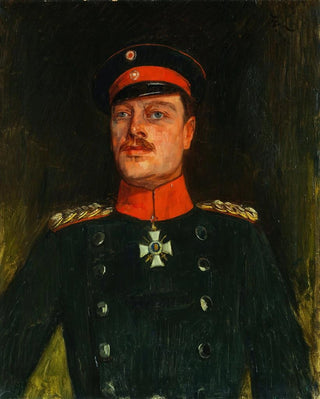Art print | Grand Duke Ernest Louis of Hesse and the Rhine - Wilhelm Trübner Source: Reproduction | Grand-duc Ernest-Louis de Hesse et du Rhin - Wilhelm Trübner


View from behind

Frame (optional)
Wilhelm Trübner's "Grand-duc Ernest-Louis de Hesse et du Rhin" art print is a striking depiction of German nobility at the end of the 19th century. This portrait, which demonstrates the artist's technical mastery, immerses us in the refined and complex universe of an era where art and politics intertwine. Gazing at this piece, one cannot help but feel a connection to the past, an invitation to explore the subtleties of aristocratic life. Trübner, through his skill in capturing not only physical features but also the very essence of his subjects, offers a fascinating insight into the personality of the grand duke, a man whose role was pivotal in the history of his region.
Style and uniqueness of the art print
Wilhelm Trübner's style is distinguished by his ability to combine realism and sensitivity. In the portrait of the grand duke, every detail is carefully considered, from the folds of the attire to the delicate nuances of the face. Trübner uses a rich and subtle color palette, creating an atmosphere that is both solemn and intimate. The background, both simple and evocative, highlights the imposing stature of the figure, while revealing a certain melancholy. The lighting, expertly orchestrated, accentuates the features of the grand duke, emphasizing his penetrating gaze and contemplative expression. This art print does not merely depict a man of power; it tells a story, that of a sovereign aware of the challenges of his time and his legacy.
The artist and his influence
Wilhelm Trübner, born in 1851, is a significant figure in German painting. His artistic journey is marked by encounters with avant-garde movements, notably the Symbolist movement and Impressionism, which profoundly influenced his approach. Trübner managed to integrate these currents while maintaining a distinct identity, making him a fully-fledged artist. His work is characterized by an exploration of human emotions, an aspect that is reflected in the portrait of the grand duke. As a professor at the Academy of Fine Arts in Karlsruhe, he also trained many artists.

Matte finish

View from behind

Frame (optional)
Wilhelm Trübner's "Grand-duc Ernest-Louis de Hesse et du Rhin" art print is a striking depiction of German nobility at the end of the 19th century. This portrait, which demonstrates the artist's technical mastery, immerses us in the refined and complex universe of an era where art and politics intertwine. Gazing at this piece, one cannot help but feel a connection to the past, an invitation to explore the subtleties of aristocratic life. Trübner, through his skill in capturing not only physical features but also the very essence of his subjects, offers a fascinating insight into the personality of the grand duke, a man whose role was pivotal in the history of his region.
Style and uniqueness of the art print
Wilhelm Trübner's style is distinguished by his ability to combine realism and sensitivity. In the portrait of the grand duke, every detail is carefully considered, from the folds of the attire to the delicate nuances of the face. Trübner uses a rich and subtle color palette, creating an atmosphere that is both solemn and intimate. The background, both simple and evocative, highlights the imposing stature of the figure, while revealing a certain melancholy. The lighting, expertly orchestrated, accentuates the features of the grand duke, emphasizing his penetrating gaze and contemplative expression. This art print does not merely depict a man of power; it tells a story, that of a sovereign aware of the challenges of his time and his legacy.
The artist and his influence
Wilhelm Trübner, born in 1851, is a significant figure in German painting. His artistic journey is marked by encounters with avant-garde movements, notably the Symbolist movement and Impressionism, which profoundly influenced his approach. Trübner managed to integrate these currents while maintaining a distinct identity, making him a fully-fledged artist. His work is characterized by an exploration of human emotions, an aspect that is reflected in the portrait of the grand duke. As a professor at the Academy of Fine Arts in Karlsruhe, he also trained many artists.






